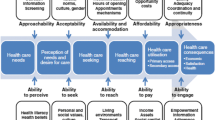Abstract
Social sector planning requires rational approaches where community needs are identified by referring to relative deprivation among localities and resources are allocated to address inequalities. Geographical information system (GIS) has been widely argued and used as a base for rational planning for equal resource allocation in social sectors around the globe. Devolution of primary health care is global strategy that needs pains taking efforts to implement it. GIS is one of the most important tools used around the world in decentralization process of primary health care. This paper examines the scope of GIS in social sector planning by concentration on primary health care delivery system in Pakistan. The work is based on example of the UK’s decentralization process and further evidence from US. This paper argues that to achieve benefits of well informed decision making to meet the communities’ needs GIS is an essential tool to support social sector planning and can be used without any difficulty in any environment. There is increasing trend in the use of Health Management Information System (HMIS) in Pakistan with ample internet connectivity which provides well established infrastructure in Pakistan to implement GIS for health care, however there is need for change in attitude towards empowering localities especially with reference to decentralization of decision making. This paper provides GIS as a tool for primary health care planning in Pakistan as a starting point in defining localities and preparing locality profiles for need identification that could help developing countries in implementing the change.
Similar content being viewed by others
References
Ishfaq, M. (1993). Decentralized resource allocation in primary health care: Formal methods and their application in Britain and Pakistan. Ph.D. thesis, LSE, London: London University.
Dickman, A., Tsoumpas, P., & Zhou, S. (1997). GIS supports social services planning in South Florida. USA: Environmental Systems Research Institute.
Bullen, N., Moon, G., & Jones, K. (1996). Defining localities for health planning: A GIS approach. Journal of Social Science and Medicine, 46(6), 801–816.
Hamilton, W. D., White, A. A., Ouellette, L., & Horacek, T. M. (2010). Use of geographical information system to determine environment support for healthful living on a North Eastern University campus. Journal of American Dietetic Association Chicago, 110(9), A_22.
Maliene, V., Grigonis, V., Palevicius, V., & Griffiths, S. (2011). Geographic information system: Old principles with new capabilities. Urban Design International, London, 16(1), 1, 6.
Maikish, A. (2010). Universal primary education and decentralization in Ghana. New York University, AAT 3404544.
Mullen, P. M. (1995). The provision of specialist services under contracting. Public Money and Management, Routledge, 15(3), 23–30.
Mcfarlane, D. R. (1992). Restructuring federalism: The effects of decentralized federal policy on states’ responsiveness to family planning needs. Women and Health, 19(1), 43–64.
Elstad, J. I. (1990). Health services and decentralized government: The case of primary health services in Norway. International Journal of Health Services, 20(4), 545–559.
Curtis, S. E., & Taket, A. R. (1995). Health and societies: Changing prospective. London: Edward Arnold.
Cordiner, R. (1956). New frontiers for professional managers. NY: McGraw-Hill.
Fesler, J. W. (1965). Approaches to the understanding of decentralization. The Journal of Politics, 27, 536–566.
Mintzberg, H. (1979). The structuring of organizations. Englewood Cliffs, NJ: Prentice—Hall Inc.
SAP-P. (2009). Profile of district, DIK with focus on livelihood related issues. South Asia Partnership—Pakistan (online). Available at http://www.semda.org.
Pakistan Census Organisation (PCO). (1998). District census report of D.I.Khan. Statistics Division, Government of Pakistan.
Williamson, O. E. (1975). Markets and hierarchies: Analysis and antitrust implications. NY: Free Press.
Taket, A. R., & Curtis, S. E. (1989). Locality planning for health care: A case study in East London. Area, 24(4), 357–364.
Curtis, S. E., & Taker, A. R. (1989). The development of geographical information system for locality planning in health care. Area, 24(4), 391–399.
National Health Policy of Pakistan. (1990). National Health Policy. Islamabad: Health Division, Government of Pakistan.
APP. (2011). National Health Policy to meet MGDs: Gilani. Associated Press of Pakistan (online). Available at http://www.app.com.pk.
National Health Policy of Pakistan. (2010). National Health Policy. Islamabad: Health Division, Government of Pakistan.
WHO (2011). Health for all by the Year 2020. WHO available at http://www.who.int.
Federal Bureau of Statistics (FBS). (2007). Pakistan statistical yearbook 2007. Islamabad: Statistics Division, Government of Pakistan.
Zachariah, K. C., & Vu, M. T. (1988). World population projections. Washington, DC: World Bank.
UN. (1983). Manual X: Indirect techniques for demographic estimation. NY: Department of International Economic and Social Affairs, UN.
Bevan, G. (1988). How can different countries achieve equity in the geographical use of health care resources. London: Department of Community Medicine, UMDS.
Goodman, S. E., & Wolcott, P. (2000). Internet in Turkey and Pakistan: A comparative analysis. Centre for International Security and Cooperation (CISAC) December 2000. http://cisac.stanford.edu/.
Qazi, M. S., Ali, M., & Kuroiwa, C. (2008). The health management information system of Pakistan under devolution: Health managers’ perceptions. Bioscience Trends, 2(2), 75–80.
Ali, M., & Horikoshi, Y. (2002). Situation analysis of health management information system in Pakistan. Pakistan Journal of Medical Research, 41(2), 64–69.
Acknowledgments
We are grateful to Mr. Kamran Latif of National Institute of Electronics, Islamabad, Pakistan for his help and contribution towards data collection and completion of this paper.
Author information
Authors and Affiliations
Corresponding author
Rights and permissions
About this article
Cite this article
Ishfaq, M., Lodhi, B.K. Role of GIS in Social Sector Planning: Can Developing Countries Benefit from the Examples of Primary Health Care (PHC) Planning in Britain?. J Community Health 37, 372–382 (2012). https://doi.org/10.1007/s10900-011-9454-7
Published:
Issue Date:
DOI: https://doi.org/10.1007/s10900-011-9454-7




